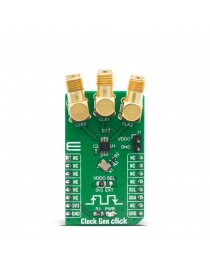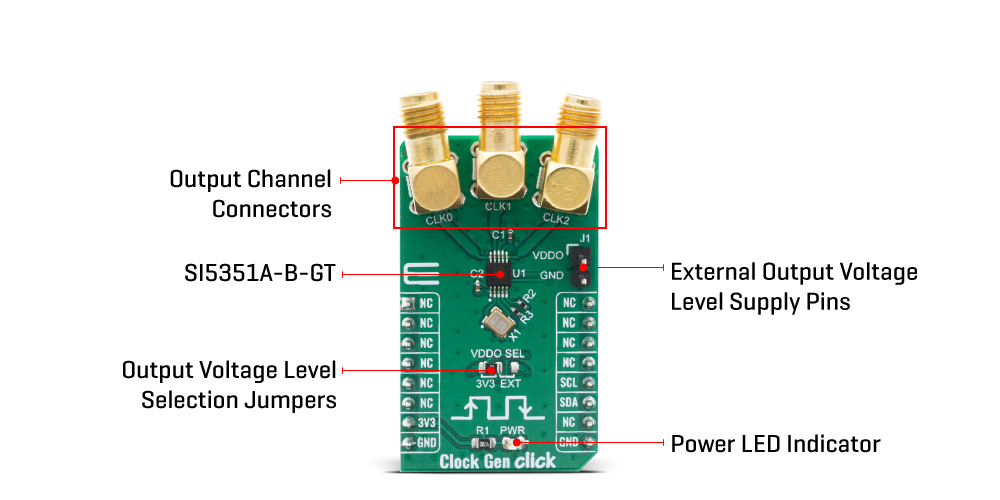

No products in the cart.


Clock Gen Click offers an ideal replacement for crystals, crystal oscillators, VCXOs, phase-locked loops (PLLs), and fanout buffers in cost-sensitive applications. This click features the Si5351A from Silicon Labs, an I2C configurable clock generator based on a PLL + high resolution MultiSynth fractional divider architecture which can generate any frequency up to 200 MHz on each of its outputs with 0 ppm error. The Si5351A is capable of generating synchronous or free-running non-integer related clock frequencies at each of its outputs (CLK0, CLK1, and CLK2), enabling one device to synthesize clocks for multiple clock domains in a design. It eliminates the need for higher cost, custom pullable crystals while providing reliable operation over a wide tuning range. The Si5351C offers the same flexibility but synchronizes to an external reference clock.
Clock Gen Click is supported by a mikroSDK compliant library, which includes functions that simplify software development. This Click board™ comes as a fully tested product, ready to be used on a system equipped with the mikroBUS™ socket.
Clock Gen click features the Si5351A, a versatile I2C programmable clock generator that is ideally suited for replacing crystals, crystal oscillators, VCXOs, PLLs, and buffers. The Si5351A consists of an input stage, two synthesis stages, and an output stage. The input stage accepts an external crystal (XTAL on XA and XB pins). The first stage of synthesis multiplies the input frequencies to an high-frequency intermediate clock, while the second stage of synthesis uses high resolution MultiSynth fractional dividers to generate the desired output frequencies. Additional integer division is provided at the output stage for generating output frequencies as low as 2.5 kHz. Crosspoint switches at each of the synthesis stages allows total flexibility in routing any of the inputs to any of the outputs. Because of this high resolution and flexible synthesis architecture, the Si5351A is capable of generating synchronous or free-running non-integer related clock frequencies at each of its outputs, enabling one device to synthesize clocks for multiple clock domains in a design.

| Type | Clock generator |
| Applications | Audio/video equipment, gaming, printers, scanners, projectors, handheld instrumentation, laser range finder, residential gateways, network/communication, servers, storage, XO replacement. |
| On-board modules | Clock Gen Click uses the SI5351A-B-GT IC, a configurable clock generator, from Silicon Labs. |
| Key Features | Configurable clock generator with three outputs, freq generator from 2.5 kHz to 200 MHz, very low power consumption |
| Interface | I2C |
| Feature | No ClickID |
| Compatibility | mikroBUS™ |
| Click board size | M (42.9 x 25.4 mm) |
| Input Voltage | 3.3V |
This table shows how the pinout on Clock Gen Click corresponds to the pinout on the mikroBUS™ socket (the latter shown in the two middle columns).
| Label | Name | Default | Description |
|---|---|---|---|
| LD1 | PWR | - | Power LED Indicator |
| JP1 | VDDO SEL | Left | Output voltage level selection 3V3/EXT, left position 3v3, right position External supply |
| Description | Min | Typ | Max | Unit |
|---|---|---|---|---|
| Core Supply Voltage | 3.0 | 3.3 | 3.6 | V |
| Output Buffer Voltage | 1.71 | 3.3 | 3.6 | V |
| Operating Temperature Range | -40 | 25 | 85 | °C |
| Output Impedance | - | 50 | - | Ω |
We provide a library for the Clock Gen Click on our LibStock page, as well as a demo application (example), developed using MikroElektronika compilers. The demo can run on all the main MikroElektronika development boards.
Library Description
Library provides functions for communicating with device via I2C module, and many functions for user to easly set frequency of device.
Key functions:
void clockgen_generic_write ( uint8_t reg_adr, uint8_t write_data ) - Function for I2C write to deviceuint8_t clockgen_generic_read ( uint8_t reg_adr ) - Function for I2C read from devicevoid clockgen_set_frequency ( uint8_t clk_num, uint8_t pll_num, uint32_t freq ) - Function for setting frequency to devicevoid clockgen_set_params ( uint8_t clk_pll_num, clockgen_params_t *param_group ) - Function for setting parameters to specific clock or pllvoid clockgen_setup_multisyinth ( uint8_t clk_num, uint32_t divider, uint32_t num, uint32_t denom, uint8_t factor ) - Function for setting OMDvoid clockgen_setup_pll ( uint8_t pll, uint8_t mult, uint32_t num, uint32_t denom ) - Function for setting FMDThis Click board™ is supported with mikroSDK - MikroElektronika Software Development Kit. To ensure proper operation of mikroSDK compliant Click board™ demo applications, mikroSDK should be downloaded from the LibStock and installed for the compiler you are using.
For more information about mikroSDK, visit the official page.